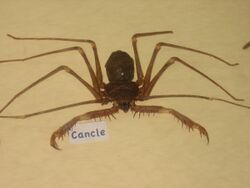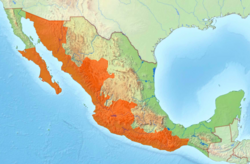Biology:Acanthophrynus
| Acanthophrynus | |
|---|---|

| |
| Acanthophrynus coronatus | |
| Scientific classification | |
| Kingdom: | Animalia
|
| Phylum: | |
| Class: | |
| Order: | |
| Family: | |
| Genus: | Acanthophrynus Kraepelin, 1899
|

| |
| A. coronatus range by state (range in Sonora is limited to the south of the state) | |
Acanthophrynus is a genus of tailless whipscorpion in the family Phrynidae containing a single species, Acanthophrynus coronatus.[1] This species is sometimes kept as a pet.[2]
Taxonomy
A. coronatus was first described by Butler in 1873 under the name Phrynus coronatus. A new genus was later described for the species by Kraepelin in 1899.[2]
Description
This tailless whipscorpion grows to a leg-span of about 18cm, being about 4cm wide, with a lifespan of around 7 years. They have light red pedipalps, and a light brown to brown prosoma, the opisthosoma being of the same color with some darker brown stripping. All of the legs are a lighter brown than the prosoma, reaching almost a yellow color. While they lack venomous glands, they do own stridulating organs.[2][3]
Distribution and habitat
A. coronatus is found in Mexico, inhabiting deciduous tropical forests of the Pacific coastal region from southern Sonora to Oaxaca, including Baja California,[2] at elevations between 0 and 1900m above sea level, though its rare they surpass 1500m. The average annual temperature in this regions are 20 to 29 °C, with average rainfall between 300mm and 1800mm, this of course depending on the region.[4]
Behavior
This species as all in the Phrynidae family are nocturnal, remaining mostly in hiding during the day, they are mostly tree dwelling, and will rarely be seen on the ground. When kept as pets, they are best kept solitary, although they have some tolerance for those of the same egg sack. Pairs can also be kept together for multiple days, but this of course comes with risks.[clarification needed] [5]
References
- ↑ Schramm, Frederic D; Valdez-Mondragón, Alejandro; Prendini, Lorenzo (2021). "Volcanism and palaeoclimate change drive diversification of the world's largest whip spider (Amblypygi)". Molecular Ecology 30 (12): 2872-2890. doi:10.1111/mec.15924.
- ↑ 2.0 2.1 2.2 2.3 de Armas, Luis F. (2006). "LOS AMBLIPÍGIDOS O TENDARAPOS DE MÉXICO (ARACHNIDA: AMBLYPYGI)". http://sea-entomologia.org/Publicaciones/PDF/BOLN39/345_359BSEA39AmblipigiosMexico.pdf.
- ↑ Shear, William (1970). "Stridulation in Acanthophrynus Coronatus (Butler) (Amblypygi, Tarantulidae)". https://www.researchgate.net/publication/27372648.
- ↑ MUSEO DE LAS CIENCIAS BIOLÓGICAS IZTACALA "ENRIQUE BELTRÁN". "SELVA BAJA CADUCIFOLIA (BOSQUE TROPICAL CADUCIFOLIO)". https://www.iztacala.unam.mx/biologiamuseo/Textos%20pdf%20Portal/SELVA%20BAJA%20CADUCIFOLIA.pdf.
- ↑ "ficha de cuidados". http://www.shny.fr/amblypygi/es/fiche_elevage.html.
Wikidata ☰ Q18094179 entry
 |

